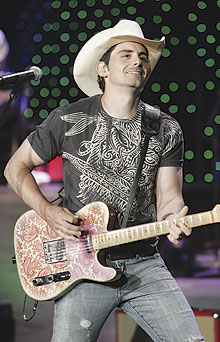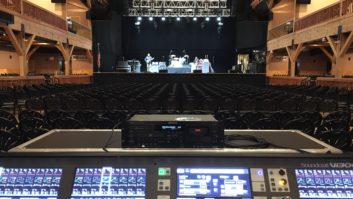
For Kevin Freeman, Brad Paisley’s longtime front-of-house mixer and production manager, touring with country music’s guitar-slingin’ hero has been going nowhere but up. “Last year in September, we had two buses, one truck, six guys in the band, five guys on the crew, a road manager, a couple bus drivers and that was about it,” he recalls. “Now there are 40 of us, four buses and five trucks, plus the opening acts [Sara Evans and Josh Turner] and all their stuff. It’s a seven-year overnight success story.”
photo: Steve Jennings
Paisley’s latest Time Well Wasted tour has bounced between all sorts of venues, including smaller arenas and sheds, while still selling out larger stadiums and pavilions, including the Sleep Train Pavilion in Concord, Calif., where Mix caught up with Paisley and crew in mid-May. However, loading in and out of these differently sized venues hasn’t made much of a difference for Freeman’s FOH mixing style. “It’s mostly about consistency and making it sound the same every day,” Freeman says. “I don’t approach it any differently. I have Jeremy [Overall, Sound Image crew chief] out here taking care of making the P.A. sound good wherever you’re sitting and I take care of making it sound good where I am. Maybe we have a little more plastic for any outdoor shows.” Plastic? “You know, in case it rains.”
In addition to the road case of plastic wrap, Freeman is packing a Sound Image — provided JBL VerTec 4889 line array system that’s crucial to the success of the show’s audio and visual aspects. “There are five video screens and two 32×32 LED screens,” he reports. “That’s 80 feet of video screen going on up there. We can’t cover it up with a P.A., but you can’t lower your standards.”
The VerTec is also crucial because of Paisley’s musical approach. “Brad plays with more dynamics than most rock bands out there,” says monitor mixer Mark Gould. “He goes from a beautiful ballad to some of the fastest guitar playing you’ve ever seen and then right back into something else. I think the P.A. does a great job from that aspect. Brad does have an amazing range of dynamics. I can tell when Kevin is having a good time because there’s more punch coming back to me.”
In addition to the set of VerTecs flown on either side of the stage, Gould puts a pair of VerTec 4889s on the stage for sidefill. “There’s not a lot of bleed or vibe coming back on the stage, so you have to add some back to put the vibe back on the stage and you can get it rocking,” Gould explains.

Front-of-house engineer/production manager Kevin Freeman at the Midas Heritage 2000—keeping levels in check
GUITAR RACKS AND THEN SOME
In addition to enjoying the stellar musicianship of Paisley’s onstage band (Ben Sesar, drums; Randle Currie, guitar; Kenny Lewis, bass; Justin Williamson, fiddle; Kendal Marcy, keyboards; and Gary Hooker, guitar), the crowd is enthralled with — and perhaps came for — Paisley’s well-known guitar licks. “Brad is a real guitar player,” Freeman says. “That’s a priority with him. He only sings to get to another solo.”
Paisley’s guitar rig — made up of an assortment of Dr. Z and a vintage Vox cabinet and a collection of pedal effects that includes names such as Axxes, Electro-Harmonix, Line 6 and Zendrive — takes up somewhere around 16 feet of backstage space. The clean amp, which is on all the time, is miked with a Shure KSM 32; the pair of effects amps gets a KSM 27. Paisley sings into a Shure 58. “We have to keep the pattern pretty tight because if we used any kind of condenser, the guitar would dwarf his vocal to where it’s almost unusable,” Gould says. “In fact, the four players in the band who sing backgrounds use a 58 for the same reason.”
Drummer Sesar uses a fairly straight-ahead kit, so Freeman mikes it accordingly with a Shure 98 and 91 on the kick, a 57 on the snare, 98s on the toms, KSM 137 as overheads and KSM 109s on the hi-hats. In addition, Gould has added a KSM 109 on the bottom of the snare to use in the drummer’s personal ear mix. Sesar also asked for the 98 and 91 combo because it sounded better for the ear mix.
Gould also adds VerTec 4880 subs to add punch to the Shure PSM 700 personal monitors. “When you hear the kick drum in the ears, you hear the low end right away with the subs instead of relying on the house, which would be delayed and that makes it hard to play in time,” Gould explains. “Now that we are playing bigger stages, we have to add vibe back on the stage.”
Currie’s pedal steel is miked with a 57 and the bass is taken DI through an Ampeg SVT direct box tube; the fiddle and keyboards are also taken DI. Hooker’s guitar rig is miked with a 57.

Monitor engineer Mark Gould creates eight personal mixes: seven for the bandmembers and one for himself.
MINIMAL FUSS FOR A FULL SOUND
Freeman’s FOH world is relatively straight-ahead, keeping his board and effects rack to a minimum. Mixing on a Midas Heritage 2000, Freeman says, “I don’t feel like reaching over 19 knobs to get to the five that I use. It’s about simplicity more than anything; everything is right there. If you are concentrating on the technology instead of what you are using the technology for,” he says with a shrug, “it’s kind of hard to focus on your band when you’re going, ‘Okay, now how do I make this console…’”
For the same reason, outboard gear is kept to a minimum, although both Freeman and Gould just added dbx 376 channel strips to their tool chests. “It really made the vocals in the [personal monitors] pop out,” the monitor engineer says.
Standing at the side of the stage, Gould works eight personal mixes throughout Paisley’s nearly two-hour set: seven for the bandmembers and one for himself so he can hear what they hear. Paisley and Sesar are the only two who get special mixes, and Gould throws a drum track and a vocal track through a splitter. Sesar, Gould reports, likes a certain sound on his snare and kick. “So I split that off to separate channels on the other end of the console so I can do for him whatever I want,” he explains. “He’s got to be comfortable for him to play well. He tends to want it quite a bit brighter than the rest of the band.”
Paisley’s vocals are split: one track is sent to him and one to the band. “That way, I can keep up with what he’s doing and not change what the band is hearing,” Gould says. “That vocal is louder and a lot more aggressive because it’s got to be in his face. I’m fighting the guitar, I’m fighting the stage volume, I’m fighting the room. That’s a neat survival technique I’ve learned.”
Most of the band, Gould explains, is dialed in early on during the set so that the night’s focus is on Paisley. And the key there, he says, is to stay flexible. “[Paisley’s] constantly changing his mix and adjusting his guitars, usually when the opening act is onstage and he’s in back fiddling with his guitar rack. I just sit there while he’s tweaking and then I turn my gain knobs. He can turn it 10 dB either way and I have to compensate.”

Sound Image crew chief Jeremy Overall
Paisley is also sensitive to nuances in his monitor mix — so much so that Gould recently returned to a Ramsa SX-1 console. “Brad just likes a warmer, smoother sound. We’ve had some other consoles out there, but it was really hard to get him to settle in,” he says. “He’d like it when he heard it, but as the shows went on, it kind of picked at him and unnerved him.”
Part of the reason that Paisley pays close attention to his sound is because he relies on it during such songs as “Whiskey Lullaby,” which features a video and audio track of Alison Krauss. “That’s the only tracked thing that we have,” reports Freeman. “She sings the second verse and harmony on the song. When she’s on the screen, there is no room for error.” Then there is the instrumental “Time Warp,” where Paisley and the band rev it up and do their best to play as fast as possible — while keeping the loudness in check.
Although he has a booming stack of Crown I-Tech I-T8000s, Freeman believes there is a distinct difference between big and loud. To that end, Freeman keeps the meter around 100 dB, topping out at 102 dB on occasion. Plus, he says, “Brad’s audiences are getting younger, but at the same time, he is a member of the Grand Ole Opry and there’s that element there, too. I think, ‘What if my parents were here?’ I don’t want to hurt those people. Loud is painful and that’s not pleasant. Big is what we’re shooting for. We’re here to take what’s going on up on the stage, make it bigger and make the audience feel it. That’s the difference between what we do and listening to a record. It doesn’t have to hurt you, but you have to feel it. That’s the concert experience. Beyond that, it’s lights, bells, whistles and video.”
David John Farinella is a San Francisco — based writer.


